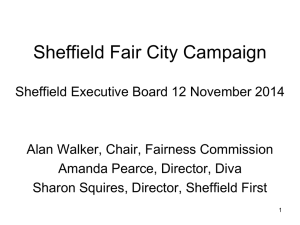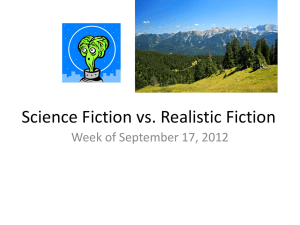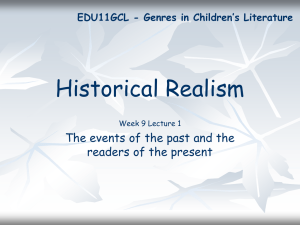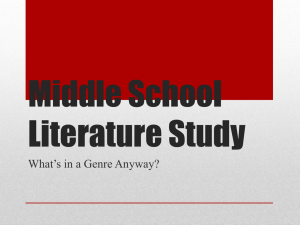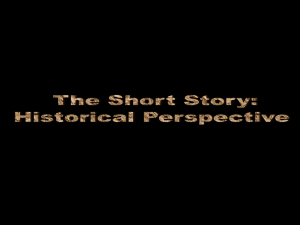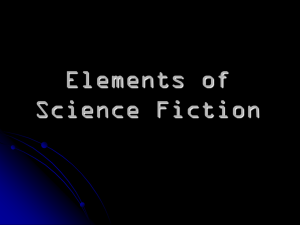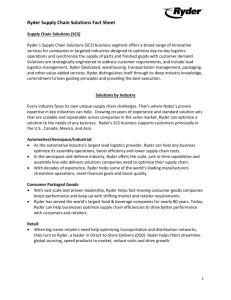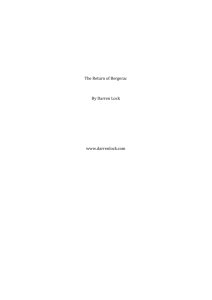ppt - Language Creation Society
advertisement
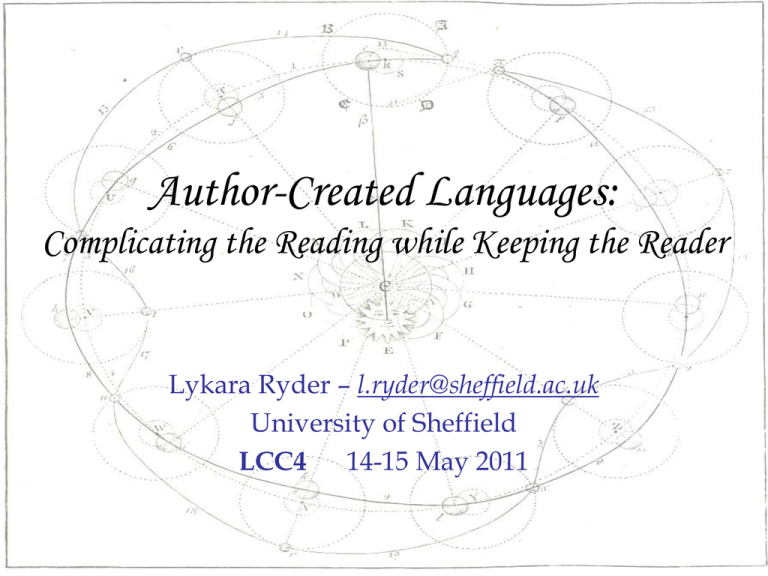
Author-Created Languages: Complicating the Reading while Keeping the Reader Lykara Ryder – l.ryder@sheffield.ac.uk University of Sheffield LCC4 14-15 May 2011 ‘Naming Languages’ ‘It begins with naming. Those who write fiction with an entirely imaginary setting fantasy or far-future or alien-world science fiction - play Adam: they must make up names for the characters and creatures of their fictive world.’ -Le Guin 2006, xvii Conlang, Conworld, Conculture, Concomitant ‘[F]or the perfect construction of an artlanguage it is found necessary to construct at least in outline a mythology concomitant. […] The converse indeed is true, your language construction will breed a mythology.’ -Tolkien 1997, 210-211 In the beginning was the word… 1. Religion, specifically the story of Babel 2. Age of Exploration 3. Language creation associated with formal language study The Man in the Moon (1638) Conveniently Christian St. Martinus -- ‘they all bowed their bodies, and held up hands in signe of great reverence: the reason whereof I learned to bee, that Martin in their language’ must be the word for God. -Godwin 1638, 82-83 Musical Transcription ‘The Difficulty of that language is not bee conceived, […] it consisteth not so much of words and Letters, as of tunes and uncouth sounds, that no letters can expresse.’ -Godwin 1638, 93 Glorie be to God alone Gonsales Matteo Ricci in China Translating the Unnamed Lunars ‘account them most base creatures, even but a degree before bruite beasts imploying them accordingly in all the basest and most servile offices, tearming them by a word that signifieth bastard-men, counterfetts, or Changelings.’ -Godwin 1638, 78-79 Cultural Conventions • ‘And his name being Irdonozur, his heires, unto this day, doe all assume unto themselves that name.’ (Godwin 1638, 76) • priceless stones ‘whereof one they call Poleastis, another Machrus, and third Ebelus.’ (Godwin 1638, 97-98) Comical History (1687) Joining Domingo Gonsales ‘They said then, (as I had it interpreted to me since) That I was infallibly the Female of the Queens little Animal. […] I observed by the muttering and gestures, both of the People and Magistrates, that they were consulting what sort of a thing I could be.’ -Cyrano de Bergerac 1687, 34 He had a nose like a sundial ‘I asked what it was a Clock several times in the Street, but they made me no answer, but by opening their Mouths, shutting their Teeth, and turning their Faces awry. How, cried all the Company, did not you know by that, that they shewed you what it was a Clock?’ -Cyrano de Bergerac 1687, 126 Sign Language Instruction • Juan Pablo Bonet published the first modern treatise on phonetics and speech therapy in 1620 • great interest in gesture-as-language for military purposes and long-distance communication Sound Recordings ‘Young-Men of that Country, were more knowing at Sixteen, or Eighteen years Old, than the Gray-Beards of our Climate; for knowing how to Read as soon as Speak, they are never without Lectures, […] they need but wind up a Spring, to hear a whole Chapter,’ -Cyrano de Bergerac 1687, 122 Moving Away from Earth/Babel Stranger spoke ‘a language, which I knew very well I had never heard before, and which hath not the least resemblance with any of the Languages in this World; notwithstanding I comprehended it faster, and more intelligibly than my Mother Tongue.’ -Cyrano de Bergerac 1687 vol. 2, 60-61 The Consolidator (1705) The Consolidator (1705) Antediluvian History ‘if it be true […], That the Chinese Empire was Peopled long before the Flood, and that they were not destroyed in the General Deluge in the Days of Noah; ‘tis no such strange thing, that they should so much out-do us’ -Defoe 2001, 26 Neologisms? • ‘he turn’d Abogratziarian, a zealous fiery Sect something like our Anti-every-bodyarians in England.’ (Defoe 2001, 19) – Abogratziarian, Abogratrianism, Abrogratzian, Abogrian, Abrograzian • ‘and this Neighbouring People, who they call Mogenites,’ (Defoe 2001, 112) Lunar poetry ‘This confusion of Circumstances has occasion’d a certain Copy of Verses to appear about the Moon, which in our Characters may be read as follows. Wondelis Idulasin na Perixola Metartos, Strigunia Crolias Xerin Hytale sylos; Farnicos Galvare Orpto sonamel Egonsberch, Sih lona Sipos Gullia Ropta Tylos. Which may be English’d thus. Caesar you Trifle with the World in vain, Think rather now of Germany than Spain; He’s hardly fit to fill th’ Eagle’s Throne, Who gives new Crowns, and can’t protect his own.’ -Defoe 2001, 121 Writing System ‘All these Translations have innumerable Hyerogliphical Notes, and Emblems painted on them, which pass as Comments, and are readily understood in that Climate.’ -Defoe 2001, 137 Conclusion - Launch Pad • Emerging ideas in linguistics • Education reforms • Tropes of language presentation • Onomatopoeia • Your thoughts, hints, suggestions? Lykara Ryder – l.ryder@sheffield.ac.uk Bibliography (1) Aarsleff, H. (1967) The Study of Language in England, 1780-1860. Princeton, NJ: Princeton University Press. Adams, P. G. (1980) Travelers and Travel Liars, 1660-1800. New York: Dover Publications Inc. Attridge, D. (2004) Peculiar Language: Literature as Difference From the Renaissance to James Joyce. London: Routledge. Barnes, M. E. (1975) Linguistics and Languages in Science Fiction Fantasy. New York: Arno Press. Bohls, E. A. and Duncan, I. (2005) Travel Writing 1700-1830: An Anthology. Oxford: Oxford University Press. Butler, J. A. (Ed) (1995) The Man in the Moon by Francis Godwin. Ottawa, Canada: Dovehouse Editions Inc. Conley, T. and Cain, S. (2006) Encyclopedia of Fictional and Fantastic Languages. London: Greenwood Press. Cornelius, P. (1965) Languages in Seventeenth- and Early Eighteenth-Century Imaginary Voyages. Genève, France: Librarie Droz. Cyrano de Bergerac, S. (1687) The Comical History of the States and Empires of the Worlds of the Moon and Sun. Translated from French by A. Lovell, A. M. London: Printed for Henry Rhodes, next door to the Swan-Tavern, near Bride Lane; in Fleet-Street. Dalgarno, G. (1661) Ars Signorum, vulgo Character Universalis, et Lingua Philosophica. London: Excudebat J. Hayes. Bibliography (2) Eco, U. (1995) The Search for the Perfect Language. Oxford: Blackwell. Gavins, J. (2007) Text World Theory: An Introduction. Edinburgh: Edinburgh University Press. Godwin, F. (1638) The Man in the Moone: Or a Discourse of a Voyage Thither by Domingo Gonsales the Speedy Messenger. London: Printed by John Norton, for Joshua Kuton, and Thomas Warren. Higley, S. L. (2007) Hildegard of Bingen’s Unknown Language: an Edition, Translation, and Discussion. New York: Palgrave MacMillan. Kendon, A. (2007) ‘On the Origins of Modern Gesture Studies’ in S. D. Duncan, J. Cassell, and E. T. Levy (Eds). Gestures and the Dynamic Dimension of Language, pp. 13-28. Amsterdam: John Benjamins. Large, A. (1985) The Artificial Language Movement. Oxford: Basil Blackwell in association with André Deutsch. Laugaa, M. and Kaplan, M. (1973) ‘Cyrano: Sound and Language’. Yale French Studies. 49, pp. 199211. Le Guin, U. K. (2006) Foreword. Encyclopedia of Fictional and Fantastic Languages. T. Conlye and S. Cain (Eds). London: Greenwood Press. Lepschy, G. (Ed) (1988) History of Linguistics Vol. 3: Renaissance and Early Modern Linguistics. London: Longman. Lewis, R. (2007) Language, Mind and Nature: Artificial Languages in England from Bacon to Locke. Cambridge: Cambridge University Press. Bibliography (3) Lewis, R. (2007) Language, Mind and Nature: Artificial Languages in England from Bacon to Locke. Cambridge: Cambridge University Press. Meyers, W. (1980) Aliens and Linguists: Language Study and Science Fiction. Athens, Georgia: University of Georgia Press. Okrent, A. (2009) In the Land of Invented Languages: Esperanto Rock Stars, Klingon Poets, Loglan Lovers, and the Mad Dreamers Who Tried to Build a Perfect Language. New York: Spiegel and Grau. Ryan, M-L. (1980) ‘Fiction, non-factuals, and the principle of minimal departure’. Poetics 9 (4), pp. 403-422. Salmon, V. (1996) Language and Society in Early Modern England. Amsterdam: John Benjamins Publishing. Schnapp, J. T. (1991) ‘Virgin’s Words: Hildegard of Bingen’s Lingua Ignota and the Development of Imaginary Languages Ancient to Modern’. Exemplaria 3 (2), pp. 267-298. Seidel, M., Novak, M. E., and Kennedy, J. D. (2001) The Consolidator by Daniel Defoe. New York: AMS Press. Semino, E. (1997) Language and World Creation in Poems and Other Texts. New York: Longman. Sisk, D. (1997) Transformations of Language in Modern Dystopias. London: Greenwood Press. Stockwell, P. (2000) Poetics of Science Fiction. Harlow: Longman. Teleman, U. (1989) ‘The World of Words – and Pictures’ in S. Allén (Ed) Possible Worlds in the Humanities, Arts and Sciences: Proceedings of Nobel Symposium 65, pp. 199-208. Berlin: Mouton de Gruyter. Bibliography (4) Tolkien, J. R. R. (1997) The Monsters and the Critics: The Essays of J. R. R. Tolkien. London: HarperCollins. van Baelen, J. (1973) ‘Reality and Illusion in “L’Autre Monde”: The Narrative Voyage’. Yale French Studies. 49, pp. 178-184. Whorf, B. L. (1956) Language, Thought, and Reality: Selected Writings. Cambridge: Technology Press of Massachusetts Institute of Technology. Wilkins, J. (1668) An Essay Towards a Real Character, And a Philosophical Language. London: Printed for Sa. Gellibrand, and for John Martin Printer to the Royal Society. Wilkins, J. (1641) Mercury, or the Secret and Swift Messenger: Shewing, How a Man may with Privacy and Speed communicate his Thoughts to a Friend at any distance. London: Printed by I. Norton, for John Maynard, and Timothy Wilkins, and are to be sold at the George in Fleestreet, neere Saint Dunstans Church. Yaguello, M. (1998) Language Through the Looking Glass: Exploring Language and Linguistics. Oxford: Oxford University Press. Lykara Ryder – l.ryder@sheffield.ac.uk University of Sheffield LCC4 14-15 May 2011

